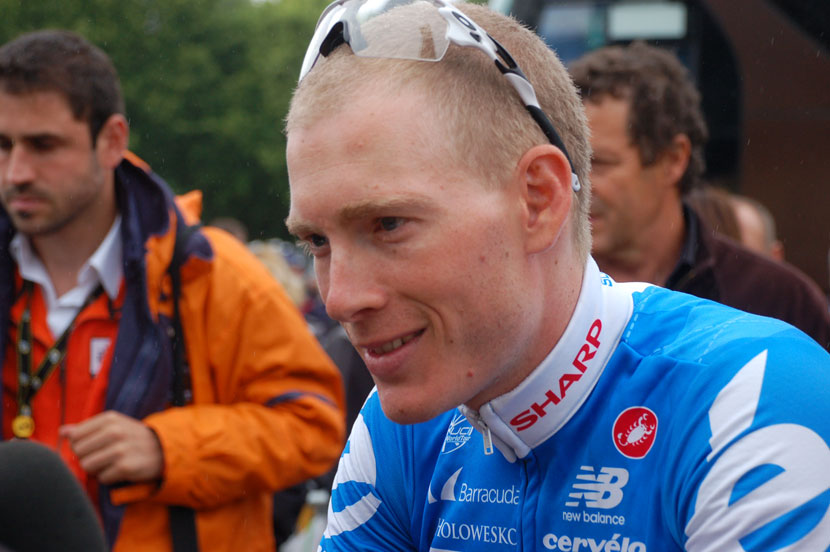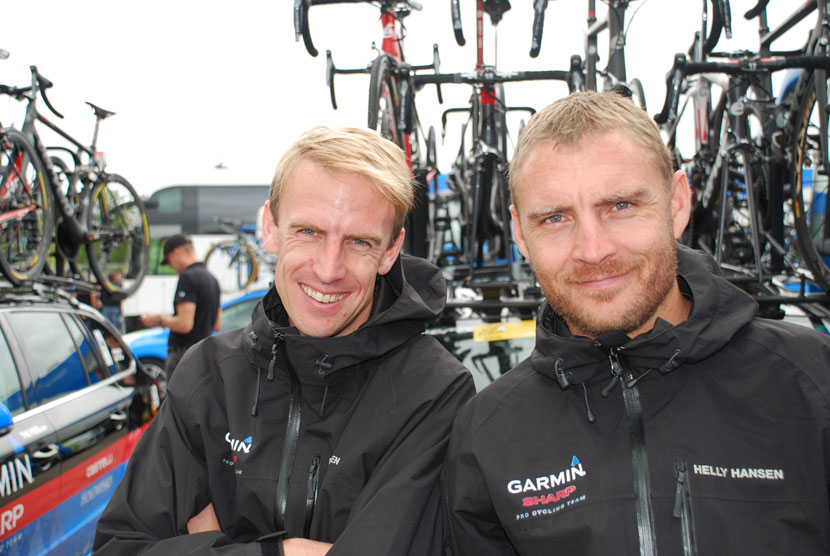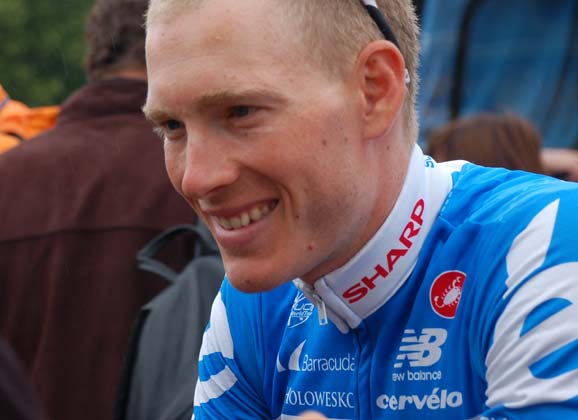During the 11th stage of the 2014 Tour de France the leader of the Garmin-Sharp team suffered a crisis. Andrew Talansky had crashed multiple times in the opening stanza of his second attempt at the race. He lost skin but never lost the motivation to try and improve on his 10th place in 2013, his first attempt at the Tour.

Andrew Talansky before the start of stage six… he may have been wounded from crashes but his spirits were still high…
Photo: Rob Arnold
The American did, however, succumb to the injuries. He lost contact with the peloton on the road to Oyonnax. He drifted well behind the bunch. His legs and mind gave way. “My back hurts but I wanted to continue for the team,” he’d say after finishing the stage in last place, 32:05 behind Tony Gallopin. “I continued for the team, for the guys. They trusted me for this Tour – I did not want to stop after everything they did for me.”
He is denoted as a DNS for the 12th stage, but the effort he put in to reach the finish will surely stand him in good stead for the rest of his career.
Earlier today, when his withdrawal from the 101st Tour was confirmed, Rob Arnold spoke to two of the directeur sportifs from Garmin-Sharp, Charly Wegelius and Robbie Hunter to get their impressions on what was a most courageous ride.
Below is a transcript of the discussion with Hunter.
(Click on the link below to listen to the interview.)
RIDE: I’ve just had a good chat with Charly [Wegelius] about Andrew Talansky’s ride in stage 11. We could see you motivating him – geeing him up – but you can’t yell at a guy so it was quite an emotional scene watching you talk through the window. I wonder, though, what he was telling you when he was on the side of the road.
Robbie Hunter: “Honestly, he wasn’t saying anything.
“I just think that any athlete who has come to the Tour with high expectations and you find yourself in a position like that, your emotions are on overdrive. And I think all the directors here understand exactly what he’s going through.
“You want to stop because you’re in pain. You want to continue because you think stopping is below you…
“And when he finally stopped he just worked himself up into such a state that he couldn’t really think clearly. I just sat down with him and said, ‘Look, sit down by the side of the road; we’ve got more than enough time to make this decision. No one is going anywhere. Think about it. Calm down. These are the pros, these are the cons… but take all the emotion out of it. Take a few deep breaths, get the tears out of your eyes…’
“And by the time I was finished talking to him – giving him all the options and telling him that the team was there and that we supported him with whatever decision he felt he needed to make…
“I told him that we had enough time to get to the finish at the speed he could ride and he stood up and said that he wanted to ride. So, from there until the finish it was basically his decision to ride.
“I didn’t tell him to get off his bike and I didn’t tell him to get on his bike.
“I just gave him the information and he processed it once all the emotion was out of it and he decided that there was a good possibility to get to the finish even if it was only a couple of minutes before the cut-off. But he wanted to get to the finish and not just walk away from the race in that manner.”

Garmin-Sharp directeurs sportif, Charly Wegelius and Robbie Hunter.
Photo: Rob Arnold
I think everyone who has ridden a bike – no matter at what level – tends to push themselves to try and do something that’s probably a bit funky. I know I’ve been up a hill and been close to tears, I’m sure you have too. I had a great interview with Geraint Thomas about 2007 when he made his [Tour] debut and he talked to me about how important you were in getting him to the finish. He said that, once he got to Paris, he realised that a four-kilometre pursuit was a piece of piss, a walk in the park.
What are you, some kind of magician motivator…?
“Nah, I just think that there are a lot of directors out there who miss the connection with the riders and it becomes just a pure job for them…
“I’ve been in the position that Andrew was in yesterday and I think that, looking back at my career, if I had a director who had maybe spoken to me the way that I spoke to him yesterday, I probably could have gone on in one or two Tours that I stopped in.
“I’m 100 per cent convinced that, in my first Tour de France [would be different]. I stopped on stage 16 or 17, when the stage was going up to Luz Ardiden and I sat on the side of the road crying [and] climbed in the car.
“The person who was with me grabbed my bike, put it on the roof and said, ‘Okay, let’s go.’
“I was totally out of it. And, looking back, if I had someone who said to me, ‘Listen, take two minutes for yourself, let’s talk about it… let’s put it in your head and see what’s going on…’ Could I have finished? Looking back at it now, 100 per cent, I could have.
“But I think you push yourself to your limits every day and when you get to those points when things aren’t working out, emotions come in, the thought process isn’t working 100 per cent… and I think you need to clarify things a little bit with certain people.
“Most sports people are more than capable of making those decisions on a clear mind. When things get clouded, the wrong decisions get made.
“I think that, honestly, with a guy like Andrew yesterday it was the right thing to do… to continue. It was a decision he made and I just try and give the guys the advice that the right decisions need to be made.
“I never push them to do anything that I don’t think they should or don’t want to do.
“All I want from the guys is when they get to the hotel at night, no matter what their decision is, they can walk away from the race or go forward in the race knowing that they are at peace with themselves.”
Bike racing is a lot about victory, isn’t it? But it’s funny: when Contador crashed out we had more messages on our Facebook page giving him support than I think he’d have received if he stood in the middle of the podium with a yellow jersey. Perhaps the same applies to Andrew yesterday. Okay, he came 10th in the Tour last year but by showing what he did, I think there are going to be a lot of people cheering him on and giving him encouragement…
“It’ll go a hell of a long way in his career and I think yesterday when he got on the bike and when he was riding on his own, I said to him he needs to realise the public that are standing out there are not booing at him, they’re encouraging him even though he’s half an hour down.
“They’re already impressed that he’s riding the race. They’re impressed that he’s on his bike. They are impressed by the courage that every single riders shows, no matter where he is – if he’s in front or at the back of the race.
“I think [Andrew] realised all of a sudden that there’s no reason to be disgraced if you came here with intentions to win the race and now, at one stage – due to crashes – all of a sudden find yourself 30 minutes down [and] literally riding to the finish at a speed that you can. That also made him realise that people are actually going to cheer them and they’re going to respect you for the effort that you’re giving.
“I think, going forward, that’s 100 per cent something that he’ll keep in his mind for the rest of his career.”
– Interview by Rob Arnold



